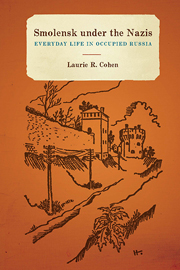Book contents
- Frontmatter
- Contents
- Acknowledgments
- Abbreviations
- Introduction
- Part 1 Methodologies
- Part 2 A Record of the War and Occupation
- Part 3 Popular Attitudes, Propaganda, and Enemy Imagery
- 6 Between Stalinists and Nazis: The Long-Term Aims and Long-Lasting Effects of Occupation
- 7 Propaganda and Persuasion
- 8 Group Perceptions, Oral Narratives
- 9 Sex/Gender Relations and Youth Experiences
- Part 4 Restoration and Reconstruction
- Conclusion
- Notes
- Bibliography
- Index
7 - Propaganda and Persuasion
from Part 3 - Popular Attitudes, Propaganda, and Enemy Imagery
Published online by Cambridge University Press: 05 December 2013
- Frontmatter
- Contents
- Acknowledgments
- Abbreviations
- Introduction
- Part 1 Methodologies
- Part 2 A Record of the War and Occupation
- Part 3 Popular Attitudes, Propaganda, and Enemy Imagery
- 6 Between Stalinists and Nazis: The Long-Term Aims and Long-Lasting Effects of Occupation
- 7 Propaganda and Persuasion
- 8 Group Perceptions, Oral Narratives
- 9 Sex/Gender Relations and Youth Experiences
- Part 4 Restoration and Reconstruction
- Conclusion
- Notes
- Bibliography
- Index
Summary
The Fascist newspaper Novyi put', published in Smolensk, trumpeted the defeat of the partisans. German scribblers, with the stroke of a pen, “destroyed” partisan groups, even as these groups increased with every day.
—Andrei KorneevPropaganda is a craft used to generate consensus. Anyone who controls the dissemination of knowledge through language and image, who “narrates or blocks other narratives from forming and emerging,” as Edward Said argued, importantly incorporates culture and imperialism. Both the Stalinist and Nazi-German regimes were highly resourceful in monopolizing knowledge and using the power of persuasion to serve their domestic and foreign political interests: to unite the collective will to victory on the one hand and undermine the opponents' will on the other. Nazi Germany's sudden invasion of the Soviet Union launched the respective propaganda ministries into direct confrontation. Like the military invasion, this “mental” invasion—National Socialism (Fascism) versus Communism (Stalinism)—was depicted as a matter of life or death. Several excellent studies have been published about the media on the Soviet home front and the Nazi-German propaganda machinery in general. This chapter examines propaganda efforts specifically in occupied Smolensk.
The success of verbal and visual propaganda efforts often lies not only in the information relayed (or prevented from disseminating) but also in the timing of the communication. The widely publicized German capture of Smolensk, for example, as mentioned in chapter 3, was heralded by the German Reich as the last step before what it called the imminent fall of Moscow.
- Type
- Chapter
- Information
- Smolensk under the NazisEveryday Life in Occupied Russia, pp. 148 - 186Publisher: Boydell & BrewerPrint publication year: 2013



